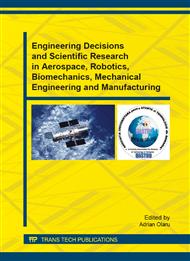p.374
p.382
p.390
p.398
p.406
p.417
p.427
p.435
p.445
Automatic Control of the Driving of Loading-Unloading Machines Used for Servicing a Rotary Hearth Furnace
Abstract:
In this paper, a solution for the automatic control of the driving mechanisms that load/unload billets in/from a rotary hearth furnace is proposed. This problem is approached because in the actual stage the control of the loading/unloading machines is made manually. The treated solution is based on using, for each machine, a direct-current motor (d.c. motor) supplied through a direct-current converter (d.c. converter) for the forward-backward moving of the two machines to/from the furnace. In this context, the tuning of the controller implemented in the converter is made in order to assure the imposed speed of the motors and implicitly of the machines, respectively an appropriate speed evolution of the motors in the period of their acceleration and deceleration to assure the machines correct positioning.
Info:
Periodical:
Pages:
406-416
Citation:
Online since:
October 2013
Authors:
Price:
Сopyright:
© 2013 Trans Tech Publications Ltd. All Rights Reserved
Share:
Citation:


